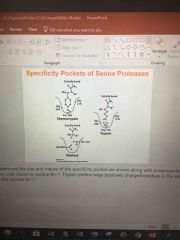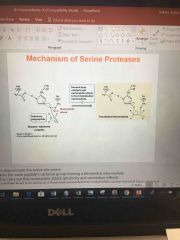![]()
![]()
![]()
Use LEFT and RIGHT arrow keys to navigate between flashcards;
Use UP and DOWN arrow keys to flip the card;
H to show hint;
A reads text to speech;
38 Cards in this Set
- Front
- Back
- 3rd side (hint)
|
Enzyme nomenclature |
Common name and 4 digit code First number major class. remaining 3 are subclasses |
|
|
|
Acid base catalysis |
Acid-donation or release of proton lowers free energy of transition states Base-acceptance of a proton/removal from reactant lowers transition state free energy -some reactions undergo both at the same time |

|
|
|
Covalent catalysis |
-accelerates reaction through formation of catalyst substrate bond. Also known as nucleophilic catalysis. Bonds transform |

|
|
|
Metal ion catalysis |
Enzymes requiring metal ion cofactor for activity. Common fe2+,fe3+, cu2+, mn 2+, co2+, zn+ |

|
|
|
Proximity and orientation effects |
Proximity and orientation of substrates/reagents can enhance rate |

|
|
|
Preferential binding of transition state |
Enzyme may bind to transition state with higher affinity than to substrates or reactants. By doing so,increases concentration of transition state and therefore reaction |
|
|
|
Enzyme specificity |
-stereospecific, geometric, physical. -enzymes are chiral and have chiral active sites making them very stereospecific in their reactions |
|
|
|
Protein nature of enzymes |
-enzymes are made of amino acids just like proteins. -because there are only 20 amino acids, this limits the variety of enzymes which can require them to have cofactors, coenzymes, prosthetic groups |
|
|
|
Cofactors |
Can be metal cation,small organic molecules or anything enzyme needs to carry out catalysis of a reaction |
|
|
|
Coenzymes |
Cofactors that are small organic molecules termed coenzymes. If they are tansiently associated with an enzyme,also called cosubstrate |
|
|
|
Prosthetic group. |
Coenzyme permanently associated with enzyme. Can be non covalent or covalently bound |
|
|
|
Holoenzymes |
Enzyme with cofactors bound to active site. Can conduct cataly |
|
|
|
Apoenzyme. |
Enzyme that are not bound to their cofactor and are inactive |
|
|
|
Transition state analogs |
-chemical compounds with similar chemical structure to the transition state -act as competitive inhibitors by blocking the enzyme active state |
|
|
|
Zymogens |
Inactive precursors of enzymes |
|
|
|
Serine proteases |
Catalyze peptide bonds through several forms of catalysis. Acid base,transition state, covalent bond, proximity and orientation |
|
|
|
General serine protease stuff |
Named so because of common mechanism involving reactive site serine residue Participates in digestion, inflammation, blood clotting and other processes |
|
|
|
DIPF and serine protease |
DIDF and similar compounds react with active site irreversibly inhibiting serine proteases |
|
|
|
Specificity pockets of serine proteases |
Side chains of key residues determine the size and nature of the specificity pocket |

|
|
|
Active site residue in serine proteases |
Trypsin, chymotrypsion and elastase have very similar primary sequence. Some bear no discernable similarities but still contain same active site and similar catalytic abilities |

|
|
|
Serine mechanism step 1 |

Back (Definition) |
|
|
|
Serine protease mech step 2 |

Back (Definition) |
|
|
|
Serine mech step 3 |

Back (Definition) |
|
|
|
Serine mech step 4 |

Back (Definition) |
|
|
|
Serine mech step 5 |

Back (Definition) |
|
|
|
Competitive inhibition |
Increases km app |
|
|
|
Uncompetitive |
Decreases km and vmax app |
|
|
|
Mixed (non competitive) |
Decreases vmax app, may increase or decrease km app |
|
|
|
Mixed/non competitive ihabiton reaction diagram |

Back (Definition) |
|
|
|
Mixed/non competitive graph |

Back (Definition) |
|
|
|
Uncompetitive inhibition reaction diagram |

Back (Definition) |
|
|
|
Uncompetitive inhabiting graph |

Back (Definition) |
|
|
|
Competitive inhabiting graph |

Back (Definition) |
|
|
|
Competitive inhibition enzyme graph |

Back (Definition) |
|
|
|
What is turnover rate equal to |

Back (Definition) |
|
|
|
What best describes catalytic efficiency |

Back (Definition) |
|
|
|
What is km describes an ideal enzyme |
Small km |
|
|
|
What kcat means an ideal enzyme |
Larger kcat means more ideal enzyme |
|

